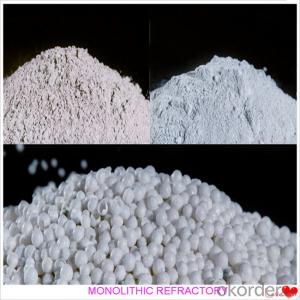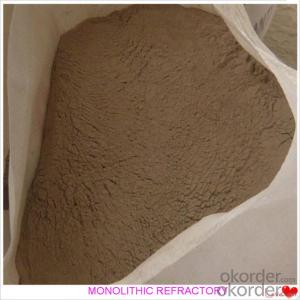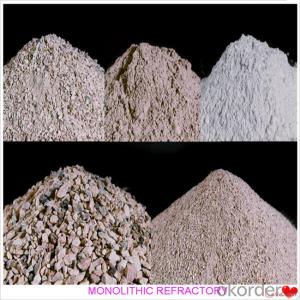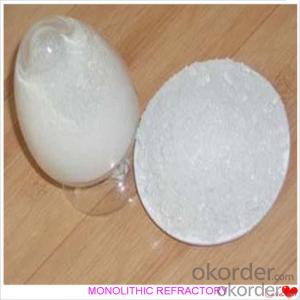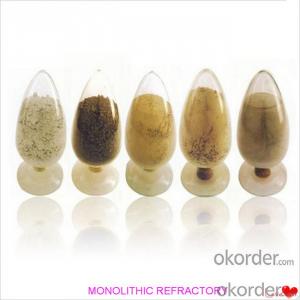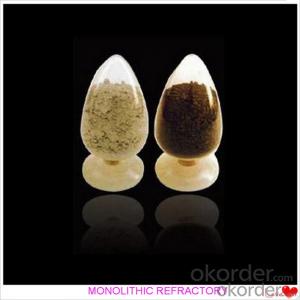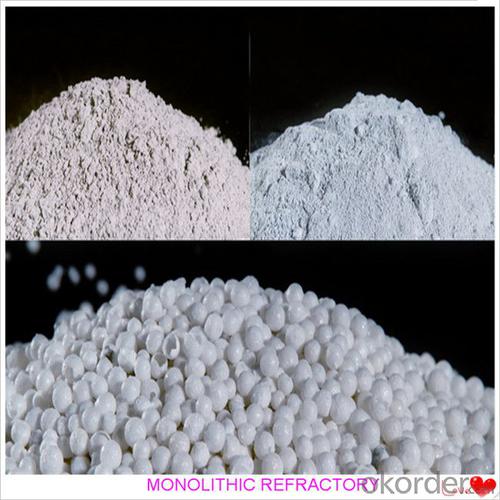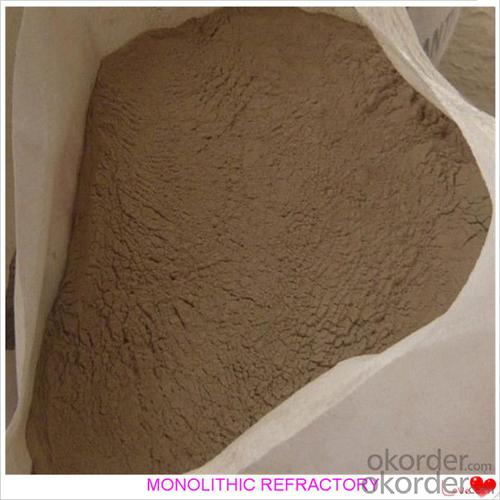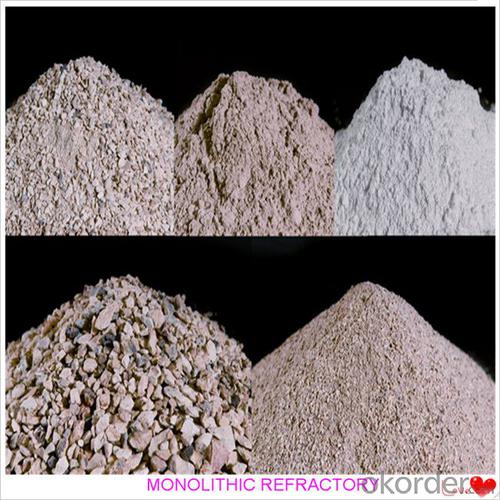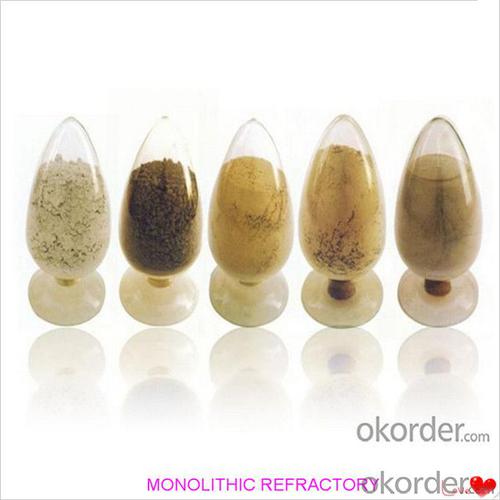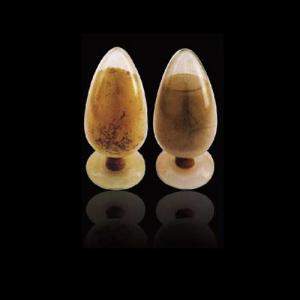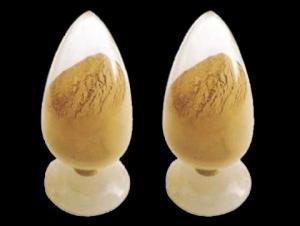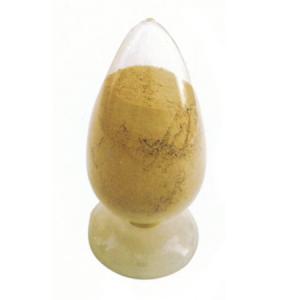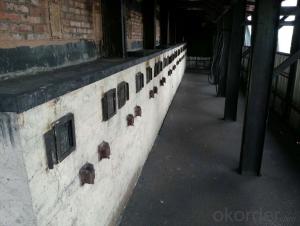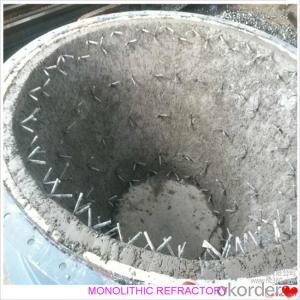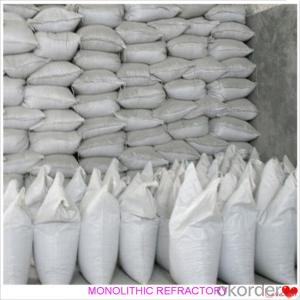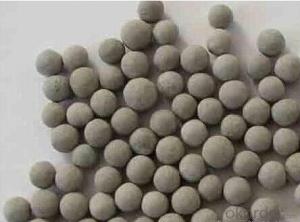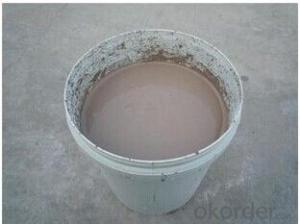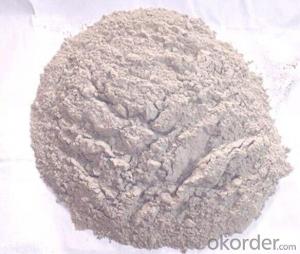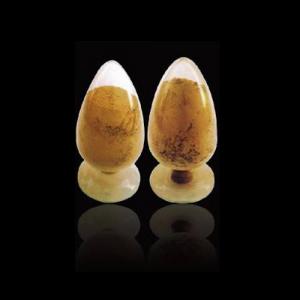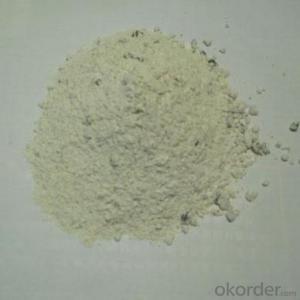Monolithic Refractories for Iron and Steel Industry - Steel Fiber Castable for Fireplace and Industrial Furnace
- Loading Port:
- China main port
- Payment Terms:
- TT OR LC
- Min Order Qty:
- 1000 kg
- Supply Capability:
- 3000000 kg/month
OKorder Service Pledge
OKorder Financial Service
You Might Also Like
Steel Fiber Castable For Fireplace and Industrial Furnace
Product Description:
Steel fiber castable is manufactured according to international standards. The product is famous for its excellent abrasion resistance and low thermal conductivity. Further, these can be provided in different specifications as required by the clients. The Steel fiber castables are used high purity raw materials and additives as the main material, and made of under superfine powder adding technology.
Product Advantages:
The material has excellent structural stability and air tightness, and has high physical and chemical properties, also has a fine working ability.They should be used with the same material products.They are widely used in various kinds of kiln lining.Such as boiler, blast furnace hot blast stove, heating furnace, ceramic kiln, etc.Furnaces of metallurgy industry, heat treatment furnace. Furnace of incineration of garbage, recirculating fluidized bed furnace. Furnaces of chemical industry and construction industry.
Product Applications:
For feature of Steel fiber castable, they have excellent abrasion resistance, thermal shock resistance, high-temperature resistance, anti-corrode and have high intensity.
Designed for refractory lining of blast furnace iron and slag runners, skimmers and soon
They can be used in troughs of small and mid size BFs and in all positions of the troughs where fast tapping is required.
Main Product Features:
1. High refractoriness, High refractoriness under load.
2. High density, low porosity.
3. Good slag resistance and corrosion resistance.
4. High strength and wear resistance.
5. Good resistance to flake performance.
6. Good thermal shock stability.
7. Scouring resistance
8. Good hot strength.
Product Specifications:
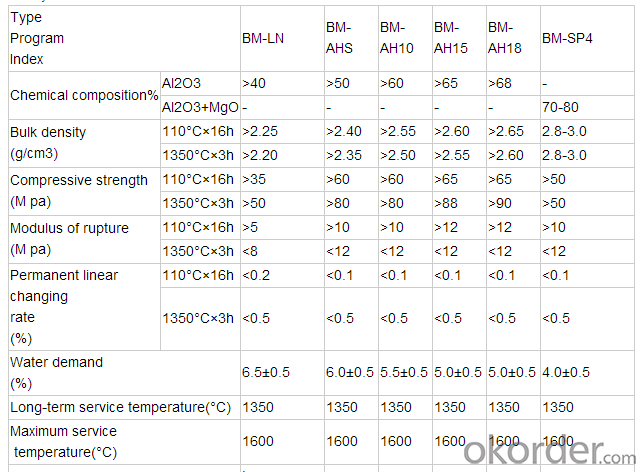
FAQ:
1. How you can control your quality?
For each production processing, we have complete QC system for the chemical composition
and Physical properties. After production, all the goods will be tested, and the quality certificate
will be shipped along with goods.
2. What's your delivery time?
It usually needs about 20days- 45 days after receiving the deposit.
3. Do you provide free samples?
Yes, we can provide a free sample for testing, If we have sample in stock,
The quantity based on the material type, The buyer should bear all the shipping costs.
4. What's your payment terms?
We can accept 30% deposit, 70% balance before shipment for ordrs over $ 2000.
5. Can we visit your Company?
Yes, certainly. You are very welcome to China and we will be honored to have a customer and friend.
Product Picture:
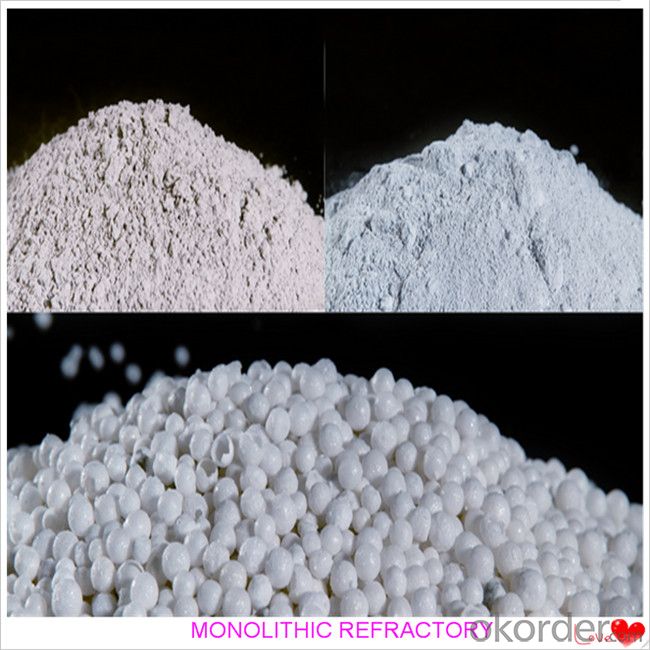
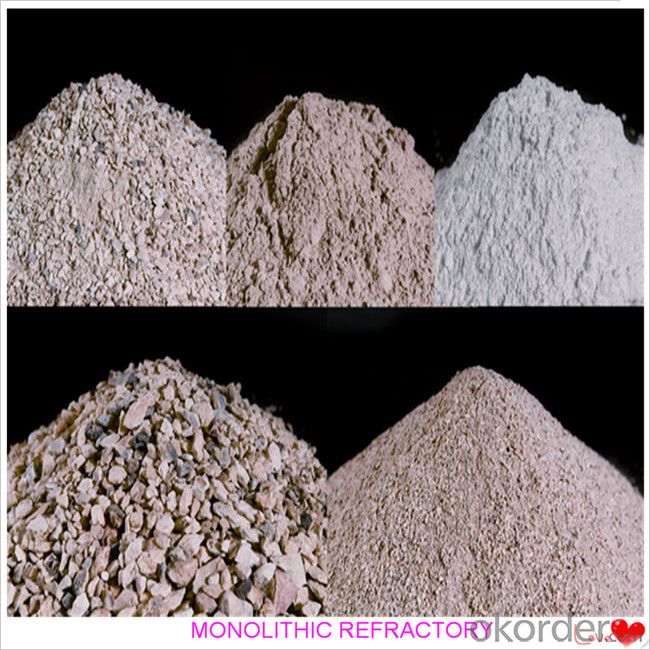
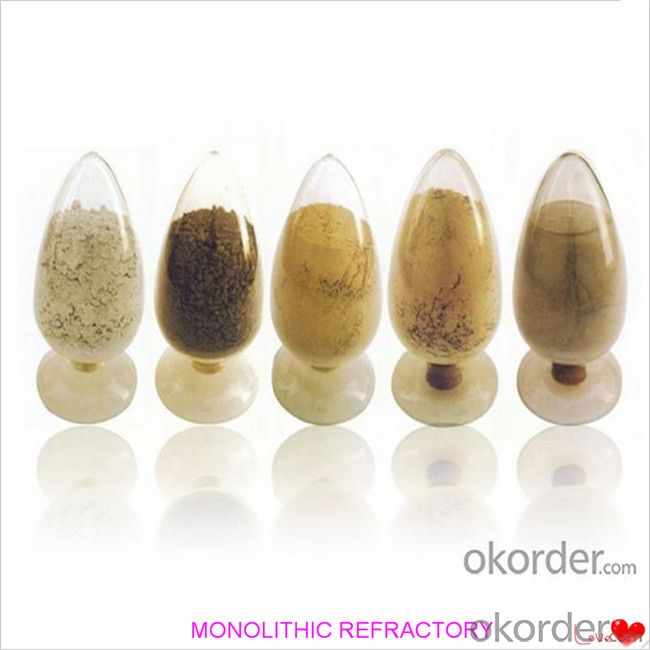
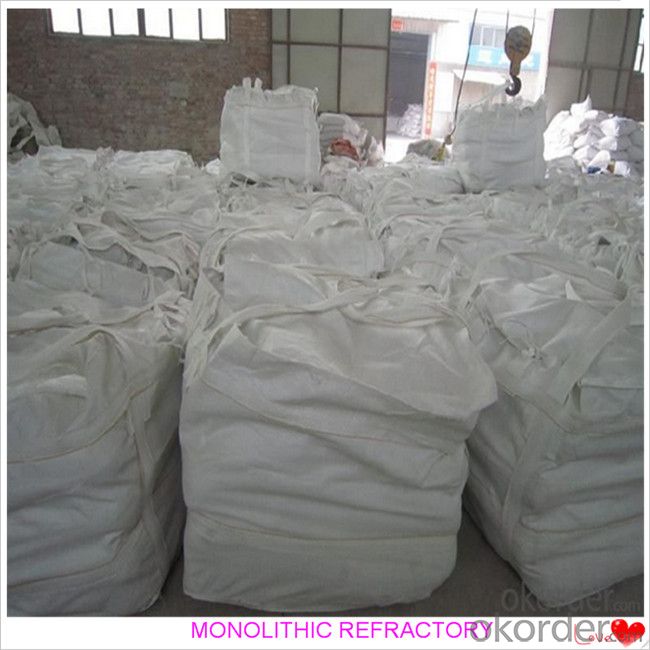
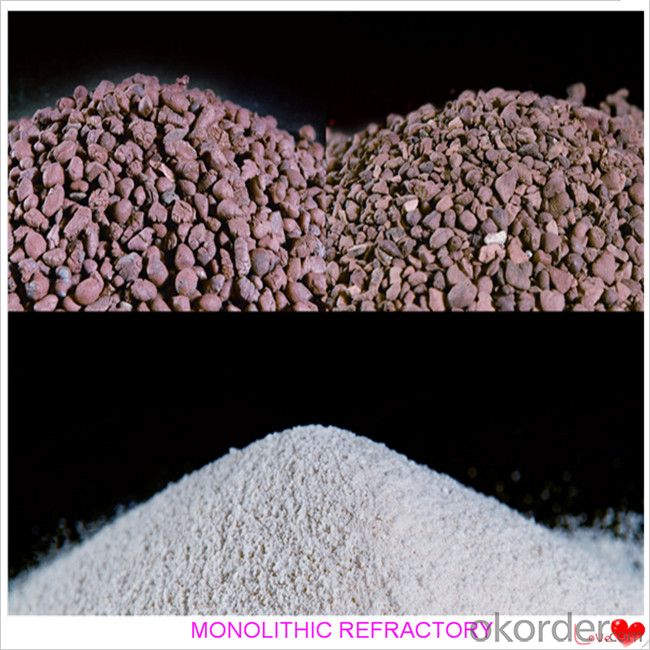
- Q: How do monolithic refractories enhance the performance and longevity of furnaces?
- Monolithic refractories play a crucial role in enhancing the performance and longevity of furnaces. These specialized materials are designed to withstand high temperatures, extreme thermal shock, and harsh chemical environments, making them ideal for lining furnaces. Firstly, monolithic refractories provide excellent insulation properties, ensuring minimal heat loss and maximum energy efficiency. By reducing heat loss, they help maintain a consistent temperature inside the furnace, allowing for more effective and efficient heating processes. This insulation also prevents the external environment from interfering with the internal temperature, ensuring stable and controlled heating operations. Secondly, these refractories have high resistance to thermal shock. Furnaces often undergo rapid temperature changes as they heat and cool down. Monolithic refractories are capable of handling these abrupt temperature fluctuations without cracking or spalling, thereby preserving the integrity of the furnace lining. This resistance to thermal shock also translates into improved safety, as it reduces the risk of sudden failure or damage to the furnace structure. Furthermore, monolithic refractories possess excellent chemical resistance, making them highly durable in aggressive environments. Furnaces are exposed to various corrosive gases, molten metals, and chemical reactions. The refractories' ability to withstand these harsh conditions ensures that the furnace lining remains intact and protects the underlying structure. This resistance to chemical attack also prevents contamination of the heated materials, ensuring the quality of the final product. Additionally, monolithic refractories offer easy installation and repair. Unlike traditional brick refractories, which require time-consuming and labor-intensive construction, monolithic refractories are typically cast or gunned into place, allowing for quick and efficient installation. Moreover, if any damage occurs, these materials can be easily patched or repaired, minimizing downtime and ensuring continuous furnace operation. In summary, monolithic refractories greatly enhance the performance and longevity of furnaces by providing excellent insulation, resistance to thermal shock, chemical durability, and ease of installation and repair. By choosing the appropriate monolithic refractory material for specific furnace applications, manufacturers can significantly improve furnace efficiency, maintain consistent temperatures, ensure safety, and prolong the lifespan of their furnaces.
- Q: How do monolithic refractories improve the efficiency of reheating furnaces in steel plants?
- Monolithic refractories play a crucial role in improving the efficiency of reheating furnaces in steel plants. These refractories are specially designed to withstand high temperatures and harsh operating conditions, making them ideal for use in steel plants. One of the key ways in which monolithic refractories enhance furnace efficiency is by reducing heat loss. These refractories have excellent insulation properties, which help to minimize heat transfer from the furnace to its surroundings. As a result, less energy is wasted, and the furnace can maintain its desired temperature more efficiently. Additionally, monolithic refractories contribute to a more uniform and controlled heat distribution within the furnace. They can be easily shaped and installed to create a seamless lining, ensuring that heat is evenly distributed throughout the furnace chamber. This uniform heat distribution prevents hotspots and cold spots, leading to a more efficient heating process. Monolithic refractories also play a crucial role in minimizing downtime and maintenance requirements. Unlike traditional brick linings, which are prone to cracking and erosion, monolithic refractories offer superior resistance to wear and tear. This enhanced durability reduces the need for frequent repairs and replacements, allowing for uninterrupted furnace operation and increased overall efficiency. Furthermore, monolithic refractories contribute to improved energy efficiency by reducing fuel consumption. The superior insulation properties of these refractories help to retain heat within the furnace, reducing the amount of energy required to maintain the desired temperature. This leads to significant energy savings for steel plants, as less fuel is needed to achieve the same heating results. In conclusion, monolithic refractories significantly improve the efficiency of reheating furnaces in steel plants by reducing heat loss, ensuring uniform heat distribution, minimizing downtime and maintenance, and reducing fuel consumption. By incorporating these refractories into their furnace linings, steel plants can enhance their productivity, reduce energy costs, and improve the overall efficiency of their operations.
- Q: How do monolithic refractories contribute to the overall efficiency of ladle transfer processes?
- Monolithic refractories contribute to the overall efficiency of ladle transfer processes by providing excellent thermal insulation and resistance to high temperatures, which helps in maintaining the heat of the molten metal during transfer. They also have high mechanical strength and erosion resistance, ensuring longer service life and reduced downtime for repairs. Additionally, monolithic refractories offer easy installation and can be shaped to fit the ladle's specific geometry, minimizing heat loss and ensuring a more efficient transfer process.
- Q: How do monolithic refractories contribute to reducing emissions in iron and steel processes?
- The reduction of emissions in iron and steel processes is greatly aided by the use of monolithic refractories, which offer a more efficient and sustainable lining solution compared to traditional brick refractories. To begin with, monolithic refractories possess a homogeneous structure that allows for easier installation and repair. This characteristic reduces the amount of time needed for maintenance, ultimately leading to increased productivity and decreased emissions. In contrast, brick refractories require more labor-intensive and time-consuming procedures for installation and repair, resulting in longer shutdown periods and higher emissions. Additionally, monolithic refractories demonstrate superior thermal insulation properties. By minimizing heat loss from furnaces or kilns, they enhance energy efficiency and decrease the amount of fuel required to reach the desired temperature. This reduction in fuel consumption directly translates into lower emissions of greenhouse gases, such as carbon dioxide, which contributes to the overall environmental sustainability of iron and steel processes. Furthermore, monolithic refractories possess excellent resistance to both thermal and chemical wear, thereby enhancing the durability and lifespan of the lining. This increased durability reduces the frequency at which refractories need to be replaced, resulting in reduced waste generation and resource consumption. By extending the service life of the lining, monolithic refractories contribute to the reduction of the environmental impact associated with the production and disposal of refractory materials. Moreover, monolithic refractories can be formulated with specialized compositions and additives to improve their resistance to corrosion and erosion, which are common challenges in iron and steel processes. By minimizing the wear and tear on the refractory lining, they help maintain the integrity of furnaces and kilns, preventing the leakage of harmful gases and pollutants that would otherwise contribute to emissions. In conclusion, monolithic refractories aid in the reduction of emissions in iron and steel processes through their ease of installation and repair, superior thermal insulation properties, increased durability, and resistance to corrosion and erosion. By optimizing energy efficiency, minimizing downtime, and reducing waste generation, monolithic refractories provide a sustainable solution for the industry, aligning with global efforts to combat climate change and promote environmental stewardship.
- Q: How do monolithic refractories help in enhancing the durability of iron and steel furnaces?
- The durability of iron and steel furnaces is greatly improved by the use of monolithic refractories, which possess unique properties and characteristics. These materials are specifically designed to endure harsh conditions and extremely high temperatures, making them the ideal choice for lining furnaces. To begin with, monolithic refractories exhibit exceptional thermal resistance, enabling them to withstand extreme heat without compromising their structural integrity. With iron and steel furnaces operating at temperatures exceeding 2,000 degrees Celsius, traditional bricks or other materials would quickly succumb to such intense heat, necessitating frequent repairs and maintenance. Conversely, monolithic refractories are capable of enduring these extreme temperatures without deterioration, thereby enhancing the durability of the furnaces. Furthermore, monolithic refractories boast a high resistance to chemical attack. In the production of iron and steel, the materials being processed often contain impurities and aggressive chemicals that can react with the furnace lining, leading to corrosion and erosion over time. However, monolithic refractories possess a remarkable ability to resist chemical attack, ensuring that the lining remains intact and durable even in the presence of corrosive elements. In addition, monolithic refractories exhibit superior mechanical strength and abrasion resistance. The movement of raw materials, stirring of molten metal, and tapping of the furnace exert mechanical stress and cause abrasion on the lining. Consequently, the lining must withstand this constant wear and tear without cracking or breaking. Monolithic refractories possess exceptional mechanical strength and can resist abrasion, thereby guaranteeing the durability and functionality of the furnace for an extended period. Moreover, monolithic refractories offer outstanding thermal shock resistance. The lining of iron and steel furnaces experiences rapid temperature changes during various stages of production. These temperature fluctuations induce thermal stress and may result in cracks or spalling of the lining. However, monolithic refractories possess low thermal conductivity and can endure thermal shock, effectively preventing any damage to the furnace lining and enhancing its durability. In conclusion, monolithic refractories contribute significantly to the durability of iron and steel furnaces by providing excellent thermal resistance, high resistance to chemical attack, superior mechanical strength and abrasion resistance, as well as exceptional thermal shock resistance. These properties ensure the integrity of the furnace lining, enabling it to withstand extreme temperatures and resist the corrosive and abrasive nature of the materials being processed. Ultimately, this prolongs the lifespan of the furnace and reduces the necessity for frequent repairs or replacements.
- Q: How are monolithic refractories used in the repair and maintenance of ladles and tundishes?
- The steel industry extensively utilizes monolithic refractories for the repair and maintenance of ladles and tundishes. These refractories are specifically designed to endure the extreme conditions encountered during the steelmaking process, including high temperatures, thermal shock, and chemical erosion. In the case of ladle repair, monolithic refractories are employed to line the inner walls. Ladles are exposed to intense heat and corrosive molten metal, and the refractory lining serves as insulation and protection against these harsh circumstances. Additionally, the lining helps to maintain the desired temperature of the molten metal, ensuring it remains in an appropriate state for processing. Regarding tundishes, monolithic refractories are used to line the bottom, sides, nozzle, and impact pad. Tundishes are responsible for distributing molten metal to multiple casting molds and are subject to high temperatures and thermal shocks. The refractory lining helps to sustain the necessary temperature and prevent any leakage of molten metal. During the repair and maintenance process, monolithic refractories are applied as dense, high-strength materials that are easy to shape and install. They can be formed into various shapes, such as bricks, castables, and gunning mixes, depending on the specific requirements of the ladle or tundish. These refractories are frequently applied using specialized techniques, such as gunning or casting, to ensure proper adhesion and durability. In addition to their thermal and chemical resistance properties, monolithic refractories also possess excellent mechanical strength and resistance to abrasion. This is particularly crucial in ladles and tundishes, as they experience constant wear and tear from the movement of molten metal and the handling of refractory materials during repair and maintenance. Overall, monolithic refractories play a vital role in the repair and maintenance of ladles and tundishes in the steel industry. They provide the necessary insulation, protection, and durability required to withstand the demanding conditions of steelmaking.
- Q: How do monolithic refractories resist chemical attacks from molten metals and slag?
- Monolithic refractories are specifically designed to resist chemical attacks from molten metals and slag. They possess several key characteristics that enable them to withstand these aggressive environments. Firstly, monolithic refractories are composed of high-quality materials that have excellent chemical resistance. These materials, such as alumina, magnesia, and chrome, have a high melting point and are stable even when exposed to extreme temperatures and corrosive substances. This chemical stability ensures that the refractory can maintain its integrity and structural strength when in contact with molten metals and slag. Secondly, monolithic refractories have a dense and compact structure. This microstructure helps to prevent the penetration of molten metals and slag into the refractory material. The dense structure acts as a barrier, limiting the contact between the corrosive substances and the refractory. This reduces the chances of chemical reactions and erosion, thereby enhancing the resistance of the refractory to chemical attacks. Furthermore, monolithic refractories often contain additives and binders that enhance their chemical resistance. These additives create a protective layer on the refractory surface, acting as a shield against chemical attacks. They can also react with certain corrosive substances, forming stable compounds that further resist the penetration and corrosion of the refractory material. Additionally, monolithic refractories are designed to have low porosity. This low porosity minimizes the absorption of molten metals and slag, preventing them from infiltrating the refractory and causing damage. By reducing the permeability of the material, the refractory can maintain its structural integrity and resist chemical attacks over prolonged periods. In conclusion, monolithic refractories resist chemical attacks from molten metals and slag through their high-quality materials, dense structure, additives, and low porosity. These combined properties allow the refractories to withstand aggressive environments and maintain their performance and longevity in industrial applications.
- Q: What are the factors affecting the thermal expansion of monolithic refractories?
- The factors affecting the thermal expansion of monolithic refractories are the composition of the refractory material, the temperature gradient, and the firing or curing process.
- Q: What are the main factors affecting the abrasion resistance of monolithic refractories?
- The main factors affecting the abrasion resistance of monolithic refractories can be categorized into three key aspects: material composition, microstructure, and service conditions. Firstly, material composition plays a crucial role in determining the abrasion resistance of monolithic refractories. The choice of raw materials, such as aggregates and binders, directly influences the overall hardness, strength, and wear resistance of the refractory. For instance, high-alumina refractories, which contain a high percentage of alumina as the main component, tend to exhibit excellent abrasion resistance due to the hardness and toughness of alumina. Conversely, refractories with a high proportion of softer materials like clay or magnesia may have lower abrasion resistance. Secondly, the microstructure of monolithic refractories greatly affects their ability to withstand abrasion. The distribution and orientation of aggregates, as well as the bond strength between the particles and the matrix, play significant roles in determining the resistance to wear. A well-distributed and interconnected network of aggregates can enhance the refractory's strength and resistance to abrasion. Additionally, a dense and well-sintered matrix can inhibit the penetration of abrasive particles, thereby reducing wear. Lastly, the service conditions in which the monolithic refractories are exposed to are crucial factors in determining their abrasion resistance. Factors such as temperature, atmosphere, and mechanical stress can significantly impact the wear behavior of refractories. High temperatures can cause thermal expansion and contraction, leading to cracks and spalling, which can accelerate abrasion. The presence of corrosive gases or chemicals can also deteriorate the refractory's microstructure, reducing its resistance to wear. Furthermore, mechanical stress from impact or friction can cause localized wear and damage the refractory. In conclusion, the main factors affecting the abrasion resistance of monolithic refractories include material composition, microstructure, and service conditions. By carefully selecting the appropriate raw materials, optimizing the microstructure, and considering the specific service conditions, it is possible to enhance the abrasion resistance of monolithic refractories and improve their overall performance in high-wear applications.
- Q: What are the advantages of using monolithic refractories in the iron and steel industry?
- Using monolithic refractories in the iron and steel industry offers several advantages. Firstly, they have excellent thermal insulation properties, allowing them to withstand and retain high temperatures. This is crucial in the manufacturing process as it ensures structural integrity, reduces the risk of failure, and maintains operational efficiency. Secondly, monolithic refractories have superior corrosion resistance. This protects equipment and structures from degradation caused by harsh chemicals and corrosive agents. It extends the lifespan of the refractories, reduces maintenance costs, and minimizes downtime. Another advantage is the versatility of monolithic refractories. Unlike traditional refractory bricks, they can be cast or sprayed into various shapes and sizes. This makes installation easier and allows for better lining design and improved performance. They can also be easily repaired or patched, minimizing production disruptions. Furthermore, monolithic refractories have excellent mechanical strength and abrasion resistance. This ensures they can withstand the constant movement and processing of materials in the industry without compromising performance. Lastly, using monolithic refractories can lead to cost savings. They require less labor and time for installation, resulting in reduced costs. Their longer lifespan, resistance to corrosion and thermal shock, also reduces the need for frequent replacements, minimizing maintenance and downtime costs. In conclusion, monolithic refractories offer advantages such as thermal insulation, corrosion resistance, versatility, mechanical strength, and cost savings. They are an ideal choice for lining furnaces, ladles, and other equipment used in the production of iron and steel.
Send your message to us
Monolithic Refractories for Iron and Steel Industry - Steel Fiber Castable for Fireplace and Industrial Furnace
- Loading Port:
- China main port
- Payment Terms:
- TT OR LC
- Min Order Qty:
- 1000 kg
- Supply Capability:
- 3000000 kg/month
OKorder Service Pledge
OKorder Financial Service
Similar products
Hot products
Hot Searches
Related keywords
